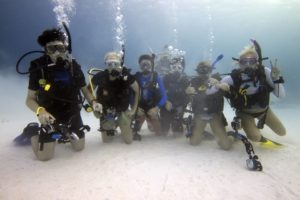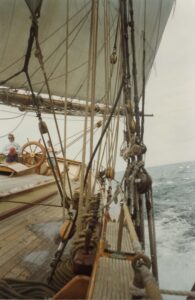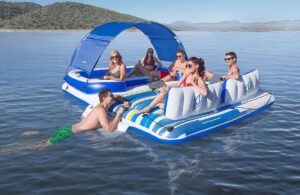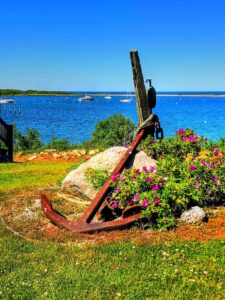Explore Marinalife’s Favorite Diving Destinations
To truly discover a destination, you must look below the surface — sometimes literally.
Here are 10 top boat-and-dive sites with unforgettable underwater views.
DEERFIELD BEACH
Deerfield Beach, FL
You might not find a better place to drift dive than along this beginner-friendly section of the Southeast Florida Reef Tract, where the Gulfstream current lazily leads you from one site to the next. The water is clear and warm, contains hundreds of species of fish and conceals the wreck of the Ancient Mariner, a 165-foot long Coast Guard Cutter allegedly inhabited by a goliath grouper, as well as Separated Rocks, a series of large underwater “islands” covered in corals and teeming with marine life. With no access to the ocean in Deerfield Beach, most divers come from nearby Pompano and use Hillsboro Inlet to enter the Atlantic.
JOHN PENNEKAMP CORAL REEF STATE PARK

Key Largo, FL
Established in 1963, the first undersea park in the United States protects about 70 square nautical miles of wafting seagrass and living reefs. While mangrove swamps and tropical hammocks create a Lost World feel close to the on-shore campsites and services, it’s the terraced gardens of hard and soft corals and the conglomeration of fish they attract that enthrall most divers. The submerged, 8½-foot tall statue Christ of the Abyss is also located within the park’s boundaries. Farther south and west, the wreck of the Coast Guard Cutter Duane offers an advanced dive under 120 feet of water in the Florida Keys National Marine Sanctuary.
GEN. HOYT S. VANDENBERG WRECK
Key West, FL
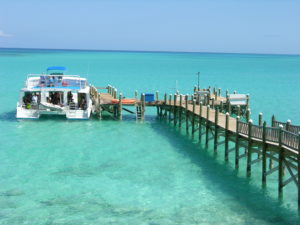 Nearly two football fields long, the Gen. Hoyt S. Vandenberg is the second-largest ship ever scuttled to create an artificial reef. What makes the former missile- tracking vessel so spectacular, beyond its sheer size, is the preparation taken to make it accessible to multiple skill levels.
Nearly two football fields long, the Gen. Hoyt S. Vandenberg is the second-largest ship ever scuttled to create an artificial reef. What makes the former missile- tracking vessel so spectacular, beyond its sheer size, is the preparation taken to make it accessible to multiple skill levels.
The keel lies at 140 feet, but the ship’s top structures reach 10 stories high, putting them within 40 to 50 feet of the surface. Parts of the boat were altered to make exploration easier and more interesting, such as holes cut into the hull to allow swim-through of the cargo holds and hallways. Be prepared to make several dives to see the whole wreck.
EXUMA CAYS LAND & SEA PARK
Exuma Cays, The Bahamas
This 176-square-mile park was founded in 1959 to safeguard the unspoiled marine environment surrounding the Exuma Cays in the Bahamas. Displaying sapphire-blue water and flawless coastlines, the nationally protected area contains 16 scrub-covered islets (some private) as well as numerous mooring sites and a visitor center on Warderick Wells. Divers can investigate isolated reefs and estuaries with healthy populations of queen conch, Nassau grouper, sea turtles and spiny lobster. Though the park is mostly water, the land acts as a vital refuge for seabirds, native lizards and the hutia, a large rodent that is the only terrestrial mammal native to the Bahamas.
MARACAIBO REEF
Cozumel Island, Mexico
Maracaibo isn’t notable for its proliferation of tropical fish but rather for its enormous vertical wall and seldom seen deep-water features. It’s a “diver’s dive” for those advanced enough to venture past 90 feet, which is where the wall starts, and descend into the abyss. The payoff is a stunning show of clefts, overhangs and secret gardens that reveal a menagerie of multicolored tubes, sponges and corals. One of the location’s most dramatic features is a large arch that cuts across the wall. You can enter its bottom at 120 feet and swim your way up through the passage it creates.
DEVIL’S GROTTO AND EDEN ROCK
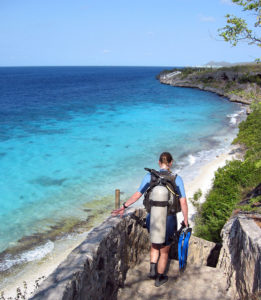
Grand Cayman, Cayman Islands
A short stroll from the docks in George Town, this two-fer of must-see sites is close to shore, lies in shallow water, offers lots to see and do and is great for new divers. Both are honeycombed with coral trenches, tunnels, caves and overhead chimneys that you can swim through along with tens of thousands of whirling, twirling silversides. Tarpon and parrotfish Tarpon and parrotfish occasionally dart in and out of the schools to snap up a snack, and you may also spot a barracuda or octopus lurking in the shadows. occasionally dart in and out of the schools to snap up a snack, and you may also spot a barracuda or octopus lurking in the shadows. You can dive both sites in one day with two tanks or take your time and enjoy each one separately.
BLOODY BAY MARINE PARK
Little Cayman, Cayman Islands
Sport Diver magazine calls Bloody Bay Wall “the most amazing drop-off in the Caribbean.” Both experts and beginners can take the plunge because the transition from gradual to vertical starts in water as shallow as 20 feet. That next step is a doozey — 1,000 feet down. Lining the wall are bountiful sponges and coral that stick out at odd angles: brilliant yellow, red and green. You’ll likely encounter a who’s who of sea creatures, from triggerfish and jacks to eagle rays and sharks. The wall is actually a string of more than a dozen sites that parallel the northwest shore, so plan to stay a while.
RMS RHONE
Salt Island, British Virgin Islands
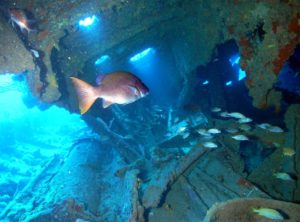
Bisset in the 1977 movie The Deep. Located about five miles from Tortola in 60 to 80 feet of water, the ship lies in three visible sections. The bow is the deepest and largest, and divers can plumb the interior to meet the residents. Reportedly, a green moray and two shy seahorses live under the nose. All that remains of the midsection is a series of support beams, and the stern features the ship’s rudder and 15-foot propeller. Eight mooring balls allow access to the site, which is only reachable by boat.
THE GREAT BLUE HOLE
Lighthouse Reef, Belize

This enigmatic dive site was made famous by Jacques Cousteau, who brought his ship, the Calypso, here to chart its depths in 1971. (For the record, the chasm measures 300 feet across and 410 feet deep.) The result of glaciation and fluctuating sea levels, the massive sinkhole presents divers with clear waters as well as a distinctly toothy array of dive buddies: nurse sharks, reef sharks, sometimes even bull sharks and hammerhead. The vertical walls are punctuated with shelves, stalactites and caves, remnants of erosion from the last ice age. Even veteran divers describe a descent into the Great Blue Hole as extraordinary, eerie and otherworldly.
A BREATH IN TIME
Pick up a 70-pound silver bar and admire a 16th-century iron treasure chest. Peer out through the hinged faceplate of a Mark V diving helmet. See William Beebe’s lab aboard the Arcturus and learn how diving influenced modern marine biology. You can do all this and more at the History of Diving Museum in Islamorada, FL. The nonprofit educational institution is dedicated to telling the story of man’s 4,000- year quest to explore under the sea by collecting, preserving, displaying and interpreting important artifacts, documents, photographs and oral histories. From early breath-holding to one-atmosphere suits for descending into the abyss, you’ll be amazed by what you see and learn at this interactive facility, perhaps adding even more depth to your favorite pastime. (divingmuseum.org)
BONAIRE MARINE PARK
Bonaire, Netherland Antilles
Starting at the shoreline and protecting the reef down to 200 feet, Bonaire Marine Park rings the island and covers 6,672 acres. Some 86 dive sites exist within its borders, many accessible right from shore with 57 species of soft and stony coral and more than 350 fish species. 1,000 Steps is noted for star coral formations and Karapata for racks of elkhorn. The Double Reef is home to five dive sites, each with a distinct look and feel, including the wreck of the Hilma Hooker. The nearby islet Klein Bonaire has additional sites, all requiring a boat.


